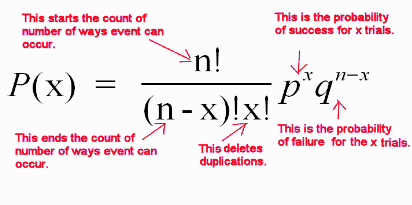-
The Binomial Formula Explained
-

- Each piece of the formula carries specific information and completes
part of the job of computing the probability of x successes in n independ only-2-event (success or failure) trials
where p is the probability of success on a trial and q is the probability of failure on the trial.
-
-
| P(x) | the probability of x successes in n independent trials |
| | |
| n! | n
factorial, n(n-1)(n-2)...(3)(2)(1) |
| | the number of ways an ordered list of n items may be formed | |
| | | -
-
| | n! | | (number of ordered lists given n things) |
| Pn,x = |
| = |
|
| | (n-x)! | | (shorten the list so only x things are used) |
-
| | n! | |
(number of ordered lists given n things) |
| Cn,x = |
| = |
|
| | (n-x)! x! |
| (shorten to only x things)(remove duplicates) |
-
-
| px | the probability of a successes on each of x trials |
| | |
-
-
| q(n-x) | the probability of a failure on the remaining trials |
| | |
-
-
-
-
Combinations Compute The Number
of Each Outcome in A Binomial Distribution -
- Printed in red above and below is the formula for a combination. A combination may be used to
compute the number of ways each outcome occurs.
-
| | n! | |
(number of ordered lists given n things) |
| Cn,x = |
| = |
|
| | (n-x)! x! |
| (shorten to only x things)(remove duplicates) | -
-
- A combination takes the number of ways to make an ordered list of n elements (n!),
shortens the list to exactly x elements ( by dividing this number by (n-x)! ), and then (by dividing by x!), it
removes the number of duplicates.
-

-
- Above, in detail, is the combinations and computation required to state for n = 4 trials,
the number of times there are 0 heads, 1 head, 2 heads, 3 heads, and 4 heads.
-
- Below are the combinations for n=1, n=2, n=3, and n=5 trials.
-

-
 - The combination function is found in the Math, Probability menu of a calculator.
-
- Combinations are used to compute a term of Pascal's triangle, in statistics to compute the number
an events, to identify the
coefficients of a binomial expansion and here in the binomial formula used to answer probability and
statistics questions.
|
-
-
-
-
One Use of The Binomial Formula
-

- What's the probability exactly 3 heads are tossed if a fair coin is flipped 4 times?
-
- The number of trials, n, is 4.
The number of successes, x, is 3.
The probability of success, p, is .5 which makes
the probability of failure, q, .5.
-
-
| | n! |
| |
P(x) = |
|
pxqn-x |
|
| | (n-x)! x! |
| |
-
-
| | 4! |
| |
P(3) = |
|
(.5)3(.5)(4-3) |
|
| | (4-3)! 3! |
| |
-
-
| | (4)(3)(2)(1) | | | P(3) = |
| (.5)(.5)(.5) (.5) |
| | | (1) (3)(2)(1) | | |
-
-
-
- This is the same answer found in a binomial distribution table for 4 trials, using 3 successes and
a probability of .5, or 1/2, on each trial.
-

-
- The table eliminates the need for the computation and is very useful when more than one problem
or a multy step problem is considered.
-
- Before considering the later type of problem, note that the probability of 3 successes in 4 trials, P(x=3), when p is .8 increases to .410 and
that with p equal to .1, P(x=3) = .004.
|
-
-
-
-
The Problem Extended
-
- Consider only the experiment flip 4 fair coins and count the number of heads. The probabilities are found
in the purple column above where p is .5 and in the table below.
-
| x | 0 | 1 | 2 | 3 | 4 |
| P(x) | .063 | .25 | .375 | .25 | .063 |
| P(x) | 1/16 | 4/16 | 6/16 | 4/16 | 1/16 |
-
- State the probabilities using mental math and the table above. It's easier to use fractions and leave
the answers unreduced as shown in the table.
-
- 1. P(x=3)
- 2. P(x=1 or x=3)
- 3. P(x=0 or x=1 or x=2)
- 4. P(x < 3)
- 5. P(x > 2)
-
- The answers follow.
-
- 1. P(x=3) = 4/16 = 1/4 = .25
-
- 2. P(x=1 or x=3) = 4/16 + 4/16 = 8/16 = 1/2 = .5
-
- 3. P(x=0 or x=1 or x=2) = 1/16 + 4/16 + 6/16 = 11/16 = .6875
-
- 4. P(x < 3)= 11/16 = .6875, the same as question 3
-
- 5. P(x > 2) = 11/16 = .6875. Because 2 is the center event and because of the
symmetry of a binomial distribution, this probability is
the same as P(x < 2) or problem 3.
|
-
-
-
-
Applications
-
- This time you know the answers. The math has already been done. This time the words and translation into the math
are the problem.
-
-
| x | 0 | 1 | 2 | 3 | 4 |
| P(x) | .063 | .25 | .375 | .25 | .063 |
| P(x) | 1/16 | 4/16 | 6/16 | 4/16 | 1/16 |
-
- State the probabilities using mental math and the table above. It's easier to use fractions and leave
the answers unreduced as shown in the table.
-
- 1. Joan must take a 4-question true-false quiz. If she doesn't even read the questions, what is the probability she will
get exactly 3 questions correct?
-
- 2. On the same quiz, what's the probability Joan gets an odd number of answers correct?
-
- 5. On the same quiz, what is the probability she gets 2 or more correct?
-
- 3. A fair wheel has the numbers 1, 2, 3, 4, 5, and 6 marked on its edge. When the wheel is spun one of the numbers is at
the top of the wheel. If the wheel is spun 4 times, what's the probability an even number is at the top fewer than 3 times?
-
- 4. Four machines have been poorly built. It's a 50/50 chance that a machine will start when it is switched on.
What's the probability that at most half of the machines will run?
-
- The answers follow.
-
- 1. P(x=3) = 4/16 = 1/4 = .25
-
- 2. P(x=1 or x=3) = 4/16 + 4/16 = 8/16 = 1/2 = .5
-
- 3. P(the number is 2 or 4 or 6 fewer than 3 times) =
P(x<3) = 1/16 + 4/16 + 6/16 = 11/16 = .6875 -
- 4. P(x < 3)= 11/16 = .6875
-
- 5. P(x > 2) = 11/16 = .6875
|
-
-
 |
![[MC,i. Home]](//www.mathnstuff.com/math/spoken/here/1gif/mcihome.gif)
![[Table]](//www.mathnstuff.com/math/spoken/here/1gif/table.gif)
![[Words]](//www.mathnstuff.com/math/spoken/here/1gif/words.gif)

![[this semester's schedule w/links]](//www.mathnstuff.com/gif/semestr.gif)
![[Good Stuff -- free & valuable resources]](//www.mathnstuff.com/gif/goods.gif)
![[next]](//www.mathnstuff.com/math/spoken/here/1gif/next.gif)
![[last]](//www.mathnstuff.com/math/spoken/here/1gif/last.gif)
© 2011, Agnes Azzolino
www.mathnstuff.com/math/spoken/here/2class/90/binom3.htm
| |

